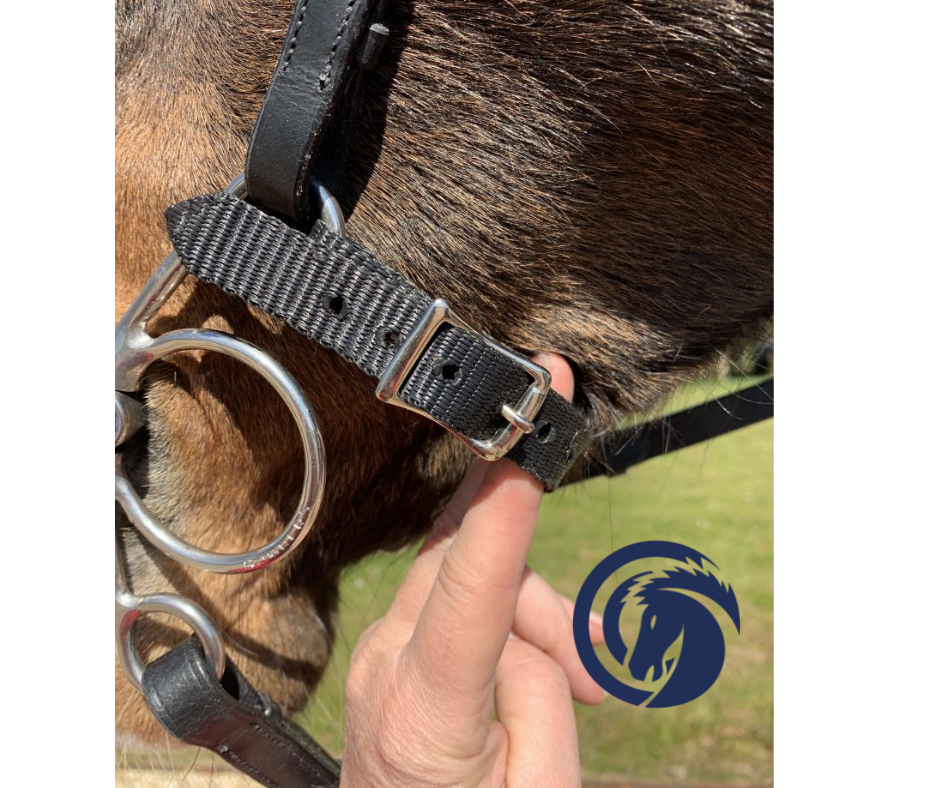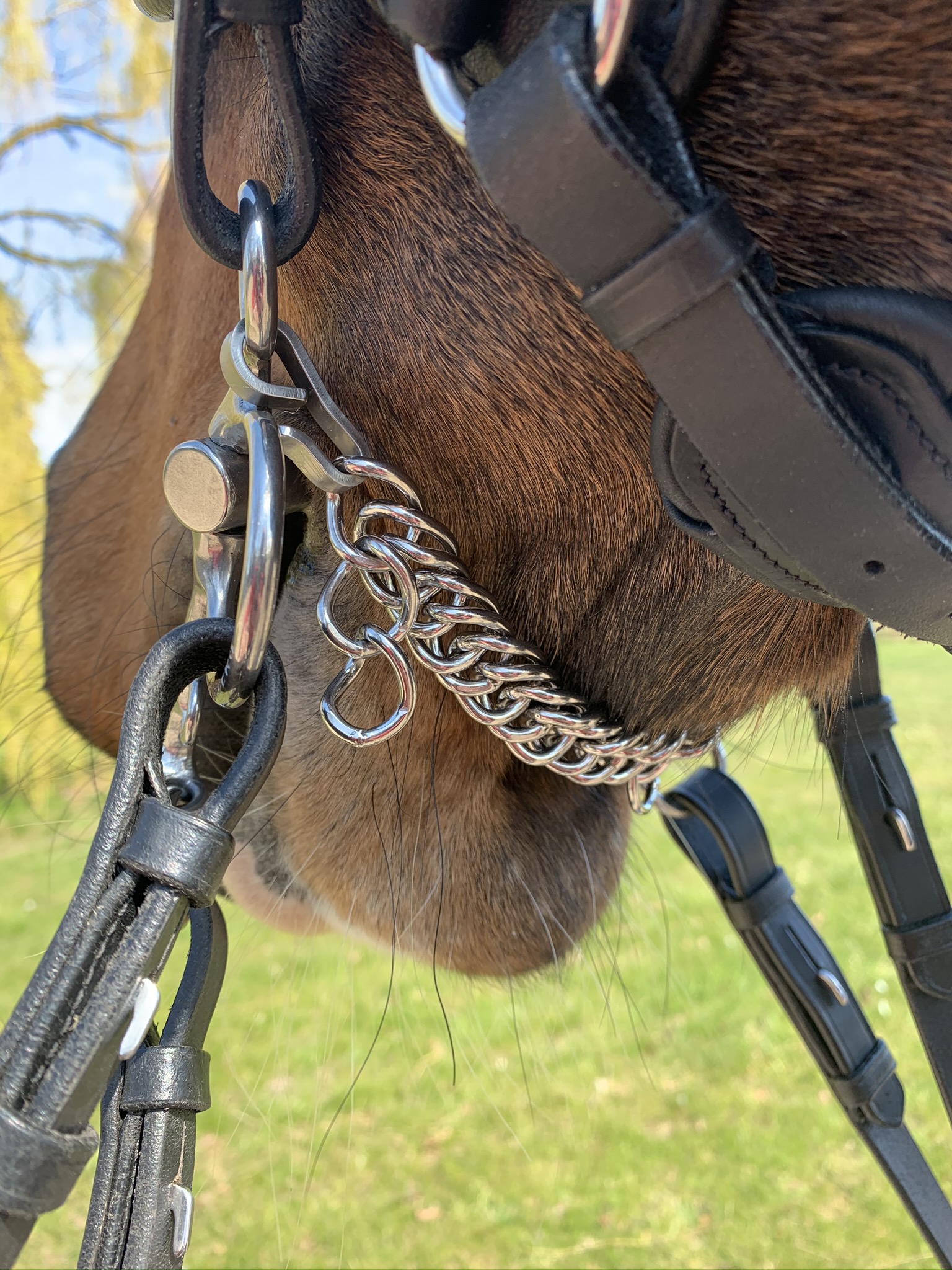In this month’s blog Kirstie and Olivia are discussing the importance of back straps and curb chains.
Back Straps and curb chains have a similar function but act on different areas of the horse and are used with specific bits. A back strap sits at the back of the jaw (just below where a standard cavesson noseband would sit) and the curb chain sits in the chin/curb groove.
The objective of both is to stabilise the bit and redistribute pressure created by lever action bits. When back straps or curb chains are engaged they alter how the bit will work in the mouth. It is important as a rider to understand their purpose and function.
- The Purpose of the Back Strap – a back strap can be used on almost any style of bit if you need more stability. The main function of the back strap is to regulate the leverage placed on the poll and redistribute that to the back of the jaw. The tightness of the back strap will dictate how much pressure is applied to the poll and the back of the jaw. The looser the back strap the more poll pressure you will apply as the bit can rotate further in the mouth. The tighter the back strap, the less the bit will rotate and more pressure is applied to the back of the jaw.
- The Purpose of a Curb Chain – the curb chain sits lower down the jaw in the chin groove. It is generally found on Pelham, Weymouth and Kimblewick bits (N.B. the Bombers Kimblewick uses a back strap). The curb chain applies pressure in the chin groove when engaged, compressing the lower jaw between the mouthpiece and the curb chain. This subsequently lessens poll pressure, and tightens the curb chain as it will be directed to the chin groove.
- It’s worth mentioning the lip strap which isn’t seen very often nowadays other than in the show ring or the hunting field. The lip strap secures the placement of the curb chain to prevent it from riding too far up and not working correctly in the chin groove.
Back Straps
Correct Placement and Fit


Material of the Back Strap.
The two main materials for back straps are nylon and leather. You can achieve a more specific fit with a nylon back strap due to being able to make a hole anywhere in the material with the buckle prong. The give in the nylon itself also softens the the feel when engaged on the horse’s jaw. A leather back strap can be slightly more challenging to fit correctly due to the set holes but it will create a more stable feel. Ensure the leather is kept clean and supple to avoid rubbing or marking.
The back straps that we sell are manufactured by Bombers Bits. They comprise of a nylon strap with a press stud and a buckle to adjust the fit. They fit literally all types of horse/pony and are easy and neat to secure and use.
The back strap also acts to regulate how fast the leverage on the mouthpiece comes into effect. When the contact is taken up, the mouth piece will slide on the loose ring; the poll pressure will come in quickly, but the leverage on the mouth piece will only come in when the mouth piece catches on the rings. The back strap will also squeeze the lower jaw between the mouth piece and the back strap. The back strap therefore plays two roles; it regulates the leverage placed on the mouth piece, and uses a squeezing action on the lower jaw. The back strap can increase pressure but it also works to spread pressure over more areas.
Which bits to use with a Back Strap.
You can use a back strap with a fixed cheek (eg elevator or Kimblewick) or loose ring lever (universal/2.5 Ring types). We would recommend using a back strap on all 2.5 Ring, Universal, Tom Thumb, Elevator, 3 Ring and 4 Ring gags as it prevents the mouthpiece from over rotating and lessening the effect of the bit.
Back Straps used to stabilise bits.
Any bit that needs stabilising in the horse’s mouth can have a back strap used. This can help to aid control and to prevent the bit from sliding through the mouth, allowing the rein aid to be very specific and immediate. You may see them being used by riders training at home or in Western disciplines. A back strap used like this is also an invaluable tool for sharpening the rein aid for tight turns that would be seen in a jump off. They are also useful for horses that need a stronger bit but are sensitive to poll pressure.
When the back strap is done up loosely it will act as a stabiliser, it stops the bit from being able to be pulled through the mouth.
We recommend that it is fitted to the width of the horse’s jaw (not pulling the bit ring in against the face) underneath where the rein fastens.
Curb Chains
When fitting the curb chain it is important to remember that the chain needs to be turned until it is flush and untwisted and then secured to sit flat in the curb groove. At Forelock and Load we recommend that you secure the curb chain so it is resting against the groove as in the photo below. We do not feel it is comfortable for the horse to have a loose chain that with movement might bang against the underside of the jaw. If your curb chain is quite long, you can double loop the end back over the hook so you haven’t got any excess chain hanging to the side.



We will be discussing this in more at a later date.
There are a number of different hooks which are used on curb bits for the curb chain to attach. Bombers Bits use flat laser cut hooks which sit flush against the face as seen in the photo below. Neue Schule use curvy hooks and some other brands use little carabiner locking clips.




